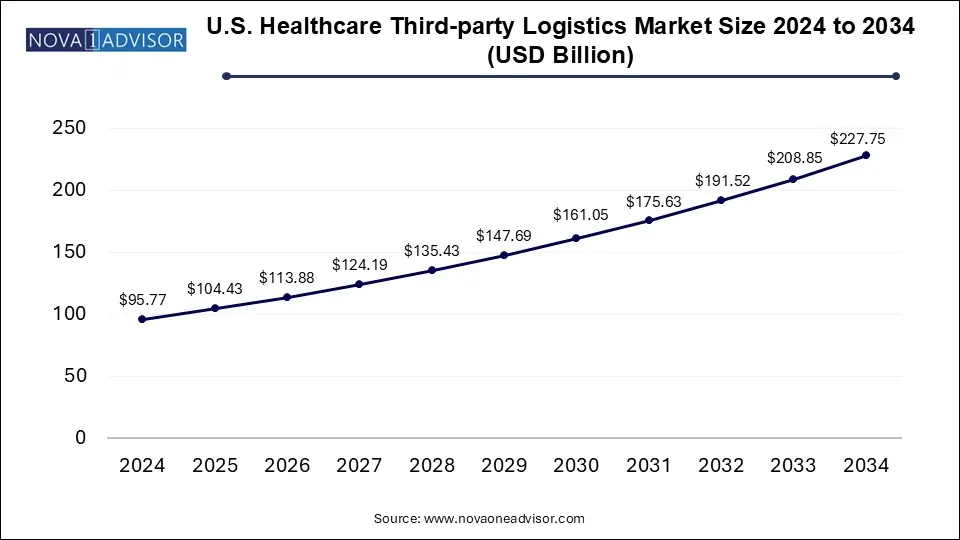The U.S. healthcare third-party logistics market size was exhibited at USD 95.77 billion in 2024 and is projected to hit around USD 227.75 billion by 2034, growing at a CAGR of 9.05% during the forecast period 2025 to 2034.

| Report Coverage | Details |
| Market Size in 2025 | USD 104.43 Billion |
| Market Size by 2034 | USD 227.75 Billion |
| Growth Rate From 2025 to 2034 | CAGR of 9.05% |
| Base Year | 2024 |
| Forecast Period | 2025-2034 |
| Segments Covered | Industry, Supply Chain, Service Type, Region |
| Market Analysis (Terms Used) | Value (US$ Million/Billion) or (Volume/Units) |
| Key Companies Profiled | ShipMonk; DHL International; Cardinal Health; MCKESSON CORPORATION; Kuehne+Nagel; AmerisourceBergen Corporation; C.H. Robinson; CEVA Logistics; Promptus, LLC; FedEx |
The market has been growing significantly due to the expanding e-commerce sector. Healthcare companies are using online platforms to sell their products because they lack the resources to provide their own logistics services, which has increased the demand for third-party logistics. Increasing technological advancements in the domain is expected to create growth opportunity for the market. The adoption of advanced technologies such as real-time tracking systems, the Internet of Things (IoT), and blockchain is becoming more accepted in healthcare logistics. These technologies support shipment tracking, visibility enhancement, and product integrity, which improve supply chain management and increase customer experience.
A complex regulatory environment related to pharmaceutical and medical devices is further expected to provide this market with growth opportunities. Storage, handling, and transportation of drugs and medical devices are all subject to stringent regulations and compliance standards in the healthcare industry. The third-party logistics entities offer expertise in navigating regulatory frameworks that can aid healthcare companies ensure compliance and avoid penalties. Safety measures and quality control requirements are often part of regulatory compliance. Third-party logistic entities help their clients maintain and implement these standards throughout the supply chain.
The COVID-19 pandemic significantly impacted the market. The COVID-19 pandemic resulted in increased demand for medical supplies such as ventilators, personal protective equipment, and other crucial products. As a result, several companies in the market adopted the changing needs of the healthcare business to meet the demand. Moreover, the COVID-19 pandemic contributed to increased partnerships between healthcare entities with third-party logistics companies to operate in a growing and changing demand.
The biopharmaceutical segment dominated the overall market with a revenue share of over 60.0% in 2024. This dominance is attributed to an increase in the number of biosimilar introductions and pharmaceutical companies' focus on their distribution network.Technological advances have increased the use of temperature management logistic services. Furthermore, the growing trend of medical companies outsourcing logistics to strengthen their distribution system is also expected to boost the segment’s growth.
The medical device segment is expected to witness the fastest growth over the forecast period. Supply chains in the medical device sector are complex and involve the sourcing of raw materials, manufacturing procedures, quality control, and distribution. 3PL providers offer expertise in enhancing productivity, cutting costs, and streamlining supply chains. They can help with order fulfillment, inventory management, shipping, and warehousing, guaranteeing a smooth supply chain from the point of production to the end-user.
The non-cold chain logistics segment generated the largest revenue share of over 60% in 2024.This is due to the rising sales of pharmaceuticals through distributors. Scalability, reduced operational costs, higher profits, and fewer risks are all features of logistic services. Due to all these advantages, third-party logistic providers have become an essential component of the pharmaceutical business.
Cold chain logistics is expected to showcase a significant market share in the coming years. There is increasing demand for temperature-sensitive biologics, pharmaceuticals, vaccines, and other healthcare products in the U.S. This demand is driven by factors such as the introduction of advanced therapies, an aging population, and the need for effective disease control. These pharmaceutical products need strict temperature control throughout the supply chain, resulting in raised dependence on cold chain logistics.
The warehousing and storage segment dominated with the largest revenue share of over 41.0% in 2024.In the healthcare industry, efficient inventory management is essential to ensuring the availability and prompt delivery of drugs and medical supplies. Warehousing and storage entities offer services such as stock rotation, and inventory tracking to simplify the supply chain processes. These services assist healthcare facilities in minimizing stockouts, increasing operational effectiveness, and optimizing inventory levels. Such advantages are expected to boost the segment growth.
The other services segment is expected to register the fastest CAGR during the forecast period.This segment includes custom & duty management, packaging, procurement services, and a few other value-added services.Procurement services are one of the crucial services of healthcare logistics. To ensure that production costs do not exceed a company's budget objectives, procurement and logistics management must coexist and function together efficiently.
The Midwest region dominated the overall market share of over 25.0% in 2024. Pharmaceutical and biotechnology companies are largely concentrated in the Midwest. These companies produce a wide variety of healthcare products, such as pharmaceuticals, biologics, medical equipment, and diagnostics. Third-party logistics services, such as warehousing, shipping, and distribution, are in high demand in the area as a result of the presence of these firms, which contributes to the Midwest's dominant position in the market.
The Northeast region is expected to show significant growth in the forecast period. The Northeast region is expected to show significant growth in the forecast period. The Northeast region has a well-established healthcare infrastructure, including clinics, hospitals, healthcare networks, and research institutions. Healthcare providers in the area rely on effective supply chain and logistics solutions for the efficient availability of equipment, drugs, and medical supplies.
This report forecasts revenue growth at country levels and provides an analysis of the latest industry trends in each of the sub-segments from 2021 to 2034. For this study, Nova one advisor, Inc. has segmented the U.S. healthcare third-party logistics market
By Industry
By Supply Chain
By Service Type
By Regional